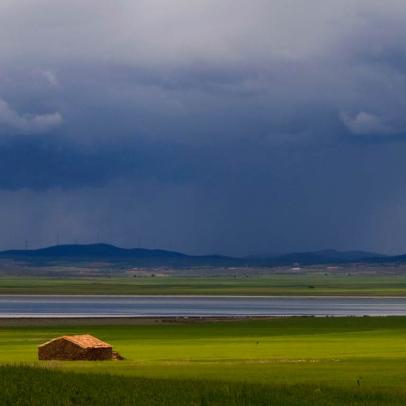The Gallocanta depression is the largest lacustrine basin in the Iberian Peninsula and is formed by nearly twenty wetlands, of which Gallocanta Lake is the largest. It is an endorheic complex in which the surface water has no outlet to other basins and therefore forms an independent hydrological system. Gallocanta Lake formed about 50,000 years ago by karst processes that caused the collapse of the basin and the sedimentation of the impermeable rocks on which it is based. The modern lake is 7.5 kilometres long and 2.5 kilometres wide. Its depth varies greatly, depending on the time of year and periods of draught, but is more than two metres deep during flooding. The water comes from a number of ravines, streams and channels that drain very irregularly into the lake.
Moreover, the supply of underground aquifers makes up for the lack of summer rain, but they are responsible for the salinity of the water. The lake is known to have dried up completely at least four times during the 20th century, when a large saline layer emerged and in the past was used to extract salt.
Every year, tens of thousands of birds find in Gallocanta a place to rest and shelter on their long journeys from the north of Europe to the places in the south of the Iberian Peninsula and Africa where they spend the winter. It’s a return journey and therefore they are found in their largest numbers on the lake in October (when they leave) and February (as they return). However, many of the birds decide to stay in the area during winter, so large colonies of them are almost a constant throughout the year. Out of all the migratory birds that visit Gallocanta, the crane (Grus grus) is undoubtedly the most representative and forms part of the identity of the lake, where concentrations of as many as 65,000 birds have been counted. In addition, the diversity of environments and settings around the lake mean that a great variety of species shelter there; indeed over 260 have been recorded.
The presence of water birds depends on the water level in the lake, but they include flocks of coots, common and red-crested pochards, mallards, teals, geese, little and great-crested grebes… On the banks there are groups of waders, such as golden and Kentish plovers, dunlins, greenshanks, godwits, lapwings, avocets and black-winged stilts. Other species such as the stone-curlew and woodcock prefer areas of tree or steppe, which they share with birds like the great bustard, black-bellied sandgrouse, and Dupont’s and calandra lark, among others.
- Access by car: as you leave the village of Gallocanta on the CV-633 road towards Berrueco, after less than 200m, turn off next to the Gallocanta Lake Interpretation Centre, which has a large car park.
- Access for people with limited mobility: the area has infrastructures adapted for people with limited mobility, including adapted parking, videos with sign language, and a gangway accessible by wheelchair as far as the observatory on the shore of the lake.
- Legal protection: the lake is inside the boundaries of the Special Protection Area for Birds ES0000017 called Gallocanta Basin, and the Gallocanta Lake Nature Reserve.
- Seasonality: it can be visited at any time of the year, but to enjoy the spectacle of the migration of the cranes, the best months are from October to March, except January. Recommendations, what to see and do: it is essential to visit the Lake Interpretation Centre.
Rev. PAB: 08.05.23


